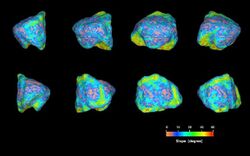Astronomy:6489 Golevka
 | |
| Discovery | |
|---|---|
| Discovered by | Eleanor F. Helin |
| Discovery date | 10 May 1991 |
| Designations | |
| (6489) Golevka | |
| 1991 JX | |
| Minor planet category | |
| Orbital characteristics[1] | |
| Epoch 6 November 2001 (JD 2452219.5) | |
| Uncertainty parameter 0 | |
| Observation arc | 8968 days (24.55 yr) |
| |{{{apsis}}}|helion}} | 4.021663 astronomical unit|AU (601.6322 Gm) |
| |{{{apsis}}}|helion}} | 0.992813 AU (148.5227 Gm) |
| 2.507238 AU (375.0775 Gm) | |
| Eccentricity | 0.604021 |
| Orbital period | 3.97 yr (1450.1 d) |
| Mean anomaly | 213.841234° |
| Mean motion | 0° 14m 53.744s / day |
| Inclination | 2.278065° |
| Longitude of ascending node | 211.596909° |
| 65.939347° | |
| Earth MOID | 0.0288423 AU (4.31475 Gm) |
| Jupiter MOID | 1.13922 AU (170.425 Gm) |
| TJupiter | 3.181 |
| Physical characteristics | |
| Mean diameter | 0.53 km[1] |
| Mass | 2.10×1011 kg |
| Mean density | 2.7+0.4 −0.6 g/cm3 |
| Rotation period | 6.026 h (0.2511 d)[1] |
| Geometric albedo | 0.151 ± 0.023[1] |
| Q | |
| Absolute magnitude (H) | 19.2[1] |
6489 Golevka is an Apollo, Mars-crosser, and Alinda asteroid discovered in 1991 by Eleanor F. Helin.
Its name has a complicated origin. In 1995, Golevka was studied simultaneously by three radar observatories across the world: Goldstone in California , Yevpatoria RT-70 radio telescope in Ukraine (Yevpatoria is sometimes romanized as Evpatoria) and Kashima in Japan . 'Golevka' comes from the first few letters of each observatory's name; it was proposed by the discoverer following a suggestion by Alexander L. Zaitsev.
Golevka is a small object, measuring 0.6 × 1.4 km. The radar observations revealed that it has a very strange, angular shape that looks different depending on the direction. In 2003 the Yarkovsky effect was first observed at work by high-precision radar observations of Golevka.[2] Between 1991 and 2003, the small force of the Yarkovsky effect caused a shift of 15 kilometers (9.3 mi) from what would be expected based on only gravitational interactions.[2] This helped evaluate the asteroid's bulk density (2.7 ± 0.5 g/cm3) and mass (2.10×1011 kg).
Golevka approaches Earth to 0.05 astronomical unit|AU (7,500,000 km; 4,600,000 mi) in 2046, 0.10 AU in 2069, and 0.11 AU in 2092.[3] On the other hand, Golevka's collision probability with any planet is negligible for at least the next nine centuries.[4] Its orbit is strikingly similar to that of 4179 Toutatis in eccentricity, semi-major axis, and inclination. However, Toutatis is better known due to a close approach to Earth in 2004.
References
- ↑ 1.0 1.1 1.2 1.3 1.4 1.5 "JPL Small-Body Database Browser: 6489 Golevka (1991 JX)". Jet Propulsion Laboratory. https://ssd.jpl.nasa.gov/sbdb.cgi?sstr=Golevka.
- ↑ 2.0 2.1 David Morrison (January 14, 2004). "Precision NEO Orbits and the Yarkovsky Effect". Asteroid and Comet Impact Hazards (NASA). http://impact.arc.nasa.gov/news_detail.cfm?ID=132.
- ↑ "NEODys (6489) Golevka". Department of Mathematics, University of Pisa, ITALY. https://newton.spacedys.com/neodys/index.php?pc=1.1.8&n=6489.
- ↑ Hudson, R. et al. (2000). "Radar observations and physical model of asteroid 6489 Golevka". Icarus 148 (1): 37–51. doi:10.1006/icar.2000.6483. Bibcode: 2000Icar..148...37H.
External links
- Intercontinental Bistatic Radar Observations of 6489 Golevka (1991 JX)
- 6489 Golevka at NeoDyS-2, Near Earth Objects—Dynamic Site
- Ephemeris · Obs prediction · Orbital info · MOID · Proper elements · Obs info · Close · Physical info · NEOCC
- 6489 Golevka at ESA–space situational awareness
- 6489 Golevka at the JPL Small-Body Database
 |

